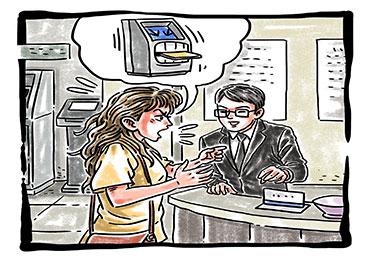ver since spring melted into summer, there’s been a steady stream of what I’ll call “returnees” – people making their first trip back to China since either before the pandemic started in early 2020, or those who had to leave during this strange time of stasis, and couldn’t get back in.
Even for Chinese friends, it’s been a culture shock. In many ways, so much has changed, and in other ways, so little has changed. Some favorite spots closed down, others replaced them, some things closed and then reopened. Many more things take place outside.
But the biggest problem, they find, is Dealing with the Bank. Doing transactions with the Bank, if you have to actually go into a branch, can suck you into a time vortex that even Dr Who and his Tardis would have difficulty getting out of. If Bill Murray’s grumpy TV anchor in Groundhog Day was forced to deal with a Chinese bank branch, he would never have become his best self, and would have remained in that day forever. It is not for the fainthearted. It’s one reason why payment apps have revolutionized life here.
Recently, an ATM ate my card. The function of the machine had changed, so you should no longer put your card in the slot, you should use a contactless function. Of course, the slot remained, and there was no sign saying don’t put your card in this machine that you’ve been using for 10 years, so it was my fault.
The important thing in this situation is absolutely to panic, or it will take days to get the card back. The next most important thing is to be a Crazy Foreigner. I have learned my lesson in this bank. Now, there are almost no service windows, unless you are important (meaning rich) enough to be taken to the Second Floor. Instead, there are roving helpers. Even if you stand glued to one of these helpers, patiently waiting for them to finish with the current customer, an elderly person will muscle in before you’ve had time to say “excuse me…” When it comes to the bank, speed and reflexes are everything, like an Olympic 100m final. Shouting “the machine ate my card” and acting like a Crazy Foreigner does have an effect.
Then the words of doom. “Do you have your passport?” Of course not, I said – I’m just going shopping. Why would I have it? He asked the senior manager – how can she prove it’s her card? Well, she said, peering at him, she can just input her password and show us. Card duly retrieved, the incident was over in a few minutes, a rare speedy success.
Personally, I haven’t used cash in years – most people don’t anymore, except my cleaning lady, who doesn’t trust banks, hence the ill-fated ATM Incident. But people coming back to China, or just visiting family and friends may find themselves having to use cash because their bank accounts are frozen, or because they can’t sign up for payment apps like WeChat Pay or Alipay – even with a foreign card. What has become an extreme convenience for us – the “Everything App” – is an extreme obstacle to everyone else. A friend just returned after three years of separation from his wife. She helped him revitalize his moribund bank account, but he had to wait several days for WeChat to verify if he could use the pay function.
I recently heard of a study exchange group from the US who had to ask 20 separate people with a Chinese bank account to verify the identities of the 20 group members so they could link their foreign credit cards to WeChat Pay. This took a long time. In the end, the group failed in their ambition, as foreign bank cards don’t put the name of the user in the same format as a passport, so their identities couldn’t be verified. Another friend, a New Yorker originally from Shenyang, now only has a US passport, and had to argue with her hometown bank over whether she was the same person.
It’s hard to explain just how much is done through apps now. I worry it will become a huge barrier for visitors to China. But then again, if it means I don’t have to deal with the Bank, who needs visitors anyway?

 Old Version
Old Version